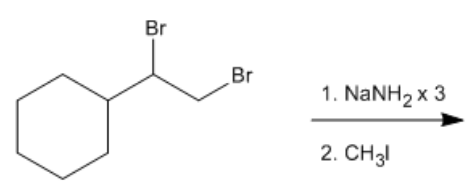What I want to talk about now is a way that we can make triple bonds into strong nucleophiles. Now that might sound weird because if you remember, triple bonds are hydrocarbons, and usually hydrocarbons aren't really good nucleophiles or electrophiles. They kind of just sit there. But it turns out that triple bonds are uniquely acidic because of a principle that we talked about way back when we talked about acid and base chemistry. And we can use that to our advantage to make them strong nucleophiles. And these are called alkanines. So, let's go ahead and talk about how we can do that. So basically, remember that we talked about in the acid and base chapter. So if you didn't watch that chapter, it's fine. I'm just going to remind you now that terminal alkynes, the alkynes that have one hydrogen at the end, are uniquely acidic due to an effect called the hybridization effect.
Now when we talked about acids and bases, we talked about that there were basically 5 effects that made things more acidic. There were the element effect, inductive effect, resonance effect, solvation effect, and hybridization effect. I know this might be like, bringing back some bad memories for you guys, or maybe you just completely have no clue what I'm talking about. But hybridization was one of the things that could make something more acidic. And here's an example of a terminal alkyne right there. And let's just go through the, you know, go through the hybridization. Basically, what the principle said was that the more s character that an atom has, the more acidic it's going to be.
And notice that this carbon right here has what kind of hybridization? It has \( sp \) hybridization. The reason it's \( sp \) is because remember that the way we figured out hybridization was you count up the number of groups or what we call bond sites, and that would tell you how what the hybridization is. So in this case, I would just have one bond over here, a second bond over here, that's 2. Two bond sites equal \( sp \). Alright? So we know the hybridization is \( sp \). Then out of the entire hybrid orbital, what percentage of that is s? That's actually really easy to figure out because you just say how many hybrid orbitals are there total? Two. There's the s and there's the p. S would be 50% of that. Okay?
Now just so you guys know, that's pretty high s character because for example \( sp^{3} \). That's a hybridization you should be really familiar with at this point. \( sp^{3} \) has 1 s and 3 p's, so that one has a 25% s character. So that one's a lot less, so having 50% is really good. That must mean this is pretty acidic. And it turns out that it is. Back in acids and bases, I made you guys memorize that the \( pKa \) of a triple bond is 25, which is unusually low for a hydrocarbon. As I said, hydrocarbons are usually not very good acids. For this to be 25, that's not bad. Alright?
So how are we going to use this to our advantage? Well, it turns out that if we can use a strong enough base, we can pull off this hydrogen and give a negative charge to the terminal alkyne. Okay? So we're going to use a strong base to deprotonate like NaNH2, or sodium amide. And both of these are very strong small bases that are going to be able to pull that hydrogen off of the terminal alkyne. So I'm talking about that green hydrogen above me. Okay? So that's going to create a strong nucleophile that we're going to call a sodium alkynide. Okay? And what the sodium alkynide looks like is it's just going to be a negative charge on that triple bond.
So if I were to just erase some of this stuff and show you what the acid-base reaction would look like for this reaction, it would be that I have, let's say, NaH. Right? Well, that's going to dissociate. Right? That would dissociate into \( Na^{+} \) and \( H^{-} \). Okay? Now the \( H^{-} \) is what's going to react. That's the base. It's going to react with the hydrogen. So I would pull off the hydrogen and donate those electrons to the triple bond, giving the triple bond a negative charge. Alright?





